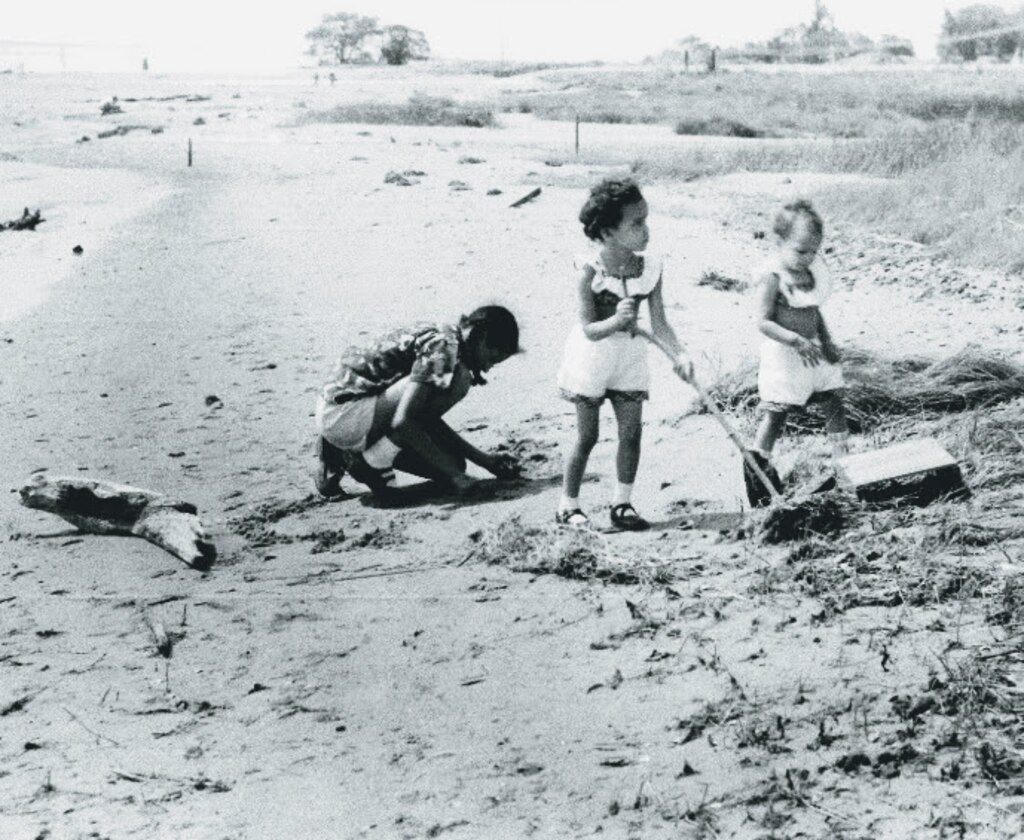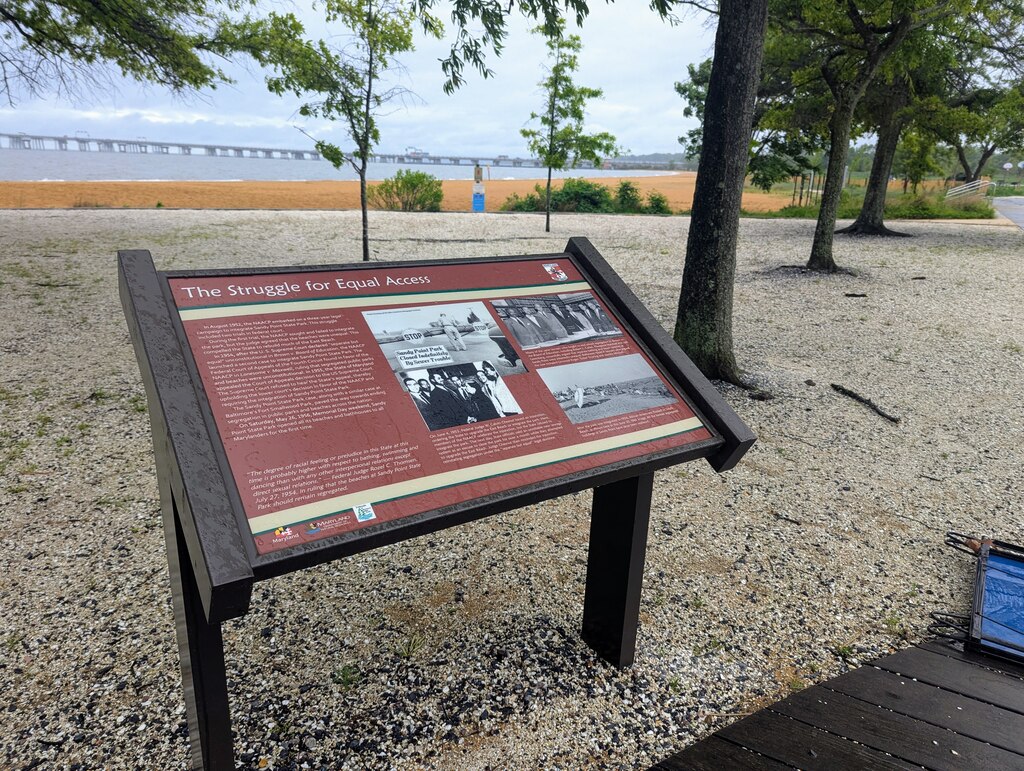Baltimore’s Afro American newspaper was jubilant.
“We’ll Swim at Public Beaches Next Summer,” its headline read.
Black Marylanders’ reliable source for news was celebrating victory in a cause it had championed for five years.
“The U.S. Supreme Court threw two more harpoons into the body of segregation,” the newspaper wrote in a full page of coverage in November 1955.
The Baltimore Banner thanks its sponsors. Become one.
Much of the history of the civil rights struggle was written in Southern states such as Alabama and Mississippi. This chapter played out on the shores of the Chesapeake Bay.
If the skies clear for Memorial Day weekend, more than 10,000 people could enjoy Sandy Point State Park near Annapolis. It’s so popular that the state instituted a reservation system this spring.
Read More
A few might stop to read storyboards along the park’s ochre sands, but most won’t think much about the legal fight that gave them this pretty spot near Annapolis.
This is where segregated public beaches and parks in America died.
“Racial segregation in recreational activities can no longer be sustained as a proper exercise of the police power of the State,” a panel of three federal judges ruled in pronouncing its end.
The Baltimore Banner thanks its sponsors. Become one.
The fight over Sandy Point started 40 minutes north, at Fort Smallwood Park, an old coastal battery on the Patapsco River in Anne Arundel County owned by Baltimore. It was part of the city’s network of whites-only pools and parks.
In the summer of 1951, activist Robert M. Dawson of Baltimore led a group of Black families onto the beach, only to be escorted off by police. The NAACP sued on their behalf, claiming the park had failed to meet the “separate but equal” doctrine that divided the country.

Baltimore squirmed. It was the law. But in the Jim Crow South, one judge noted, the only thing more objectionable than Blacks and whites swimming or dancing together was interracial sex.
So the city proposed one week each summer month for swimming by “Negroes.” When a judge refused, it reluctantly agreed to create segregated beaches.
“For the first time in the park’s history,” The Evening Sun gasped just before Memorial Day 1952, “both races will be permitted in the water at the same time.”
The Baltimore Banner thanks its sponsors. Become one.
Maryland noticed. Gov. William Preston Lane Jr. wanted the state to have its own bayfront park, so in 1949 he bought 675 acres next to his proposed bridge across the bay for $160,000.
When Gov. Theodore Roosevelt McKeldin opened the park a month after the Fort Smallwood protest, freshly painted signs directed white visitors to the South Beach, with showers, picnic tables and playgrounds.
Black visitors could use the East Beach, a stretch of undeveloped shoreline.
Milton Lonesome of Baltimore led a group of Black families to the South Beach, only to be walked out of the park. The NAACP sued, arguing that the East Beach was not equal.
One federal judge ruled that Baltimore could have separate beaches as long as they were equal. Another said Maryland had to improve the East Beach.
The Baltimore Banner thanks its sponsors. Become one.
When the NAACP asked the judge to enforce his order, the state shut down Sandy Point for the Fourth of July in 1953.
That same summer, a Black child drowned in the Patapsco River while swimming with friends. The NAACP sued the city again, claiming the ban on Blacks in all but one municipal pool on the other side of the city was responsible.

The tide turned.
In 1954, the Supreme Court ruled in Brown v. the Board of Education that separate schools violated the Equal Protection Clause of the Fourteenth Amendment.
So, in Maryland, the NAACP dropped its argument over “equal” beaches, combined its lawsuits and appealed to the Fourth Circuit Court of Appeals in North Carolina on the grounds of “separate.”
The Baltimore Banner thanks its sponsors. Become one.
“We are not asking the Governor or his Commission to close the beaches,” NAACP attorney Linwood Koger Jr. told the Afro American, “but to open them on an unsegregated basis to all.”
The appeals court panel decided in March 1955 that Brown made segregated beaches impossible.
“Liberty under the law applies to the full range of conduct that the individual is free to pursue,” the judges wrote.
The state and the city appealed to the Supreme Court, giving segregated summers one last gasp. When the high court met in October, it merged the Maryland case with one over Atlanta golf courses and desegregated all public facilities.
“God is good; the whole nation will benefit from our struggles for freedom and democracy,” Baltimore NAACP President Lillie Jackson told the Afro American.
The Baltimore Banner thanks its sponsors. Become one.
Baltimore soon abandoned Fort Smallwood Park, even trying to give it away. When Anne Arundel finally agreed to take the park in 2005, it paid just $1.
Another 19 years passed before the swimming beach reopened, and now the county is working to tell the story in a new visitors center.
Sandy Point, meanwhile, has only grown in popularity. Today, 1 million people visit yearly, most heading to the South Beach and its view of the Bay Bridge.
The beach was mostly empty on a recent rainy afternoon, waiting for summer weekend crowds to return.
Naval Academy mids were breaking down exercise equipment on the South Beach. Bishop McNamara students laughed under the East Beach picnic pavilions.

You might have heard the argument that the end of segregated public beaches like Sandy Point gave rise to the spread of neighborhood and backyard pools in the decade that followed. Maybe.
But Maryland changed a lot in those 10 years.
Suburbs spread from Baltimore to Annapolis and around Washington, and swimming pools came with them.
Some of it was racism. There was also cheaper construction, the opening of the Bay Bridge in 1952 and the quick decline of bay resorts that followed. Even the Hollywood “aquamusicals” of swimmer and actress Esther Williams contributed.
If you go swimming this weekend, take a second to think about why societies change.
Sometimes it’s about the fight for equal treatment under the law.
And sometimes it’s about having a welcoming place to go swimming.





Comments
Welcome to The Banner's subscriber-only commenting community. Please review our community guidelines.